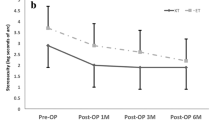Abstract
Purpose
To investigate the effect of different types of convergent strabismus on horizontal eye movements and compare data with healthy control subjects.
Materials and methods
This prospective, cross-sectional study included 38 patients with convergent strabismus (16 fully accommodative, 13 partially accommodative and 9 non-accommodative esotropia) and 19 age-matched control subjects. All of the participants had a detailed ophthalmological examination including visual acuity assessment, cover-uncover prism test, slit lamp, and indirect ophthalmoscopy examination. Videonystagmography (VNG) was used for the evaluation of horizontal eye movements such as saccadic accuracy, velocity, latency, and smooth pursuit velocity gain.
Results
The saccadic accuracy in the rightward direction was lower in the fully accommodative esotropia group compared to the partially accommodative esotropia group in the right eye (p = 0.002). The saccadic latency in the rightward direction was longer in the fully accommodative esotropia group compared to the control group (p = 0.008) and smooth pursuit velocity gain in the leftward direction was lower in the partially and non-accommodative esotropia group compared to the control group in binocular recording (p = 0.004, p = 0.001, respectively). There was no difference in the saccadic velocity among the study groups (p > 0.05). Finally, asymmetry of saccadic velocity and latency was observed between right- and leftward directions in the partially accommodative esotropia group in the right eye (p = 0.003, p = 0.008, respectively).
Conclusion
This study demonstrated that horizontal eye movements may vary in different types of convergent strabismus. VNG may be an auxiliary tool to the clinical examination in differentiating fully or non-accommodative esotropia.


Similar content being viewed by others
References
Buttner U, Kremmyda O (2007) Smooth pursuit eye movements and optokinetic nystagmus. Dev Ophthalmol 40:76–89
Lions C, Bui-Quoc E, Wiener-Vacher S et al (2013) Smooth pursuit eye movements in children with strabismus and in children with vergence deficits. PLoS ONE 8(12):e83972
Bucci MP, Brémond-Gignac D, Kapoula Z (2009) Speed and accuracy of saccades, vergence and combined eye movements in subjects with strabismus before and after eye surgery. Vision Res 49(4):460–469
Ciuffreda KJ, Kenyon RV, Stark L (1979) Abnormal saccadic substitution during small-amplitude pursuit tracking in amblyopic eyes. Invest Ophthalmol Vis Sci 18(5):506–516
Tychsen L, Hurtig RR, Scott WE (1985) Pursuit is impaired but the vestibulo-ocular reflex is normal in infantile strabismus. Arch Ophthalmol 103(4):536–539
Ghasia FF, Otero-Millan J, Shaikh AG (2018) Abnormal fixational eye movements in strabismus. Br J Ophthalmol 102(2):253–259
Bedell HE, Yap YL, Flom MC (1990) Fixational drift and nasal-temporal pursuit asymmetries in strabismic amblyopes. Invest Ophthalmol Vis Sci 31(5):968–976
Raab EL (2016) Accommodative ET-high AC/A ratio Esotropia: the case for glasses. Am Orthopt J 66(1):1–4
Kenyon RV, Ciuffreda KJ, Stark L (1980) Dynamic vergence eye movements in strabismus and amblyopia: symmetric vergence. Invest Ophthalmol Vis Sci 19(1):60–74
Tychsen L, Scott C (2003) Maldevelopment of convergence eye movements in macaque monkeys with small- and large-angle infantile esotropia. Invest Ophthalmol Vis Sci 44(8):3358–3368
Gaertner C, Bucci MP, Ajrezo L et al (2013) Binocular coordination of saccades during reading in children with clinically assessed poor vergence capabilities. Vision Res 87:22–29
Eizenman M, Sapir-Pichhadze R, Westall CA et al (2006) Eye-movement responses to disparity vergence stimuli with artificial monocular scotomas. Curr Eye Res 31(6):471–480
Kim EH, Alvarez TL (2012) The frequency of horizontal saccades in near and far symmetrical disparity vergence. Vision Res 63:9–19
Bucci MP, Kapoula Z, Yang Q et al (2006) Latency of saccades, vergence, and combined movements in children with early onset convergent or divergent strabismus. Vision Res 46(8–9):1384–1392
Klein C, Foerster F (2001) Development of prosaccade and antisaccade task performance in participants aged 6–26 years. Psychophysiology 38(2):179–189
Yang Q, Bucci MP, Kapoula Z (2002) The latency of saccades, vergence, and combined eye movements in children and in adults. Invest Ophthalmol Vis Sci 43(9):2939–2949
Findlay JM, Walker R (1999) A model of saccade generation based on parallel processing and competitive inhibition. Behav Brain Sci 22(4):661–74 (discussion 674–721)
Ciuffreda KJ, Kenyon RV, Stark L (1978) Processing delays in amblyopic eyes: evidence from saccadic latencies. Am J Optom Physiol Opt 55(3):187–196
Perdziak M, Witkowska DK, Gryncewicz W et al (2016) Not only amblyopic but also dominant eye in subjects with strabismus show increased saccadic latency. J Vis 16(10):12
Funding
No funding was received for conducting this study.
Author information
Authors and Affiliations
Contributions
All authors contributed to the study conception and design. Material preparation, data collection and analysis were performed by [MH], [BM], [MG], [MTT], [AM], [HO] and [MTK]. The first draft of the manuscript was written by [MH] and all authors commented on previous versions of the manuscript. All authors read and approved the final manuscript.
Corresponding author
Ethics declarations
Confilct of interest
The authors have no relevant financial or non-financial interests to disclose.
Ethical approval
This study was performed in line with the principles of the Declaration of Helsinki. Approval was granted by the Ethics Committee of Göztepe Prof. Dr. Süleyman Yalçın City Hospital (Date 10/02/2021/No 2021/0105).
Informed consent
Written informed consent was obtained from the parents.
Additional information
Publisher's Note
Springer Nature remains neutral with regard to jurisdictional claims in published maps and institutional affiliations.
Rights and permissions
About this article
Cite this article
Hepokur, M., Mutlu, B., Güneş, M. et al. The effect of different types of convergent strabismus on horizontal eye movements. Int Ophthalmol 42, 3951–3961 (2022). https://doi.org/10.1007/s10792-022-02379-2
Received:
Accepted:
Published:
Issue Date:
DOI: https://doi.org/10.1007/s10792-022-02379-2



